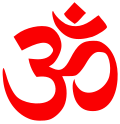Brihaddharma Purana
Appearance
| Part of a series on |
| Hindu scriptures and texts |
|---|
 |
| Related Hindu texts |
The Brihaddharma Purana (
Hindu religious text, which classified itself (I.25.26) as the last of the 18 Upapuranas. The extant text comprises three khaņḑas (parts): pūrvakhaņḑa, madhyakhaņḑa and uttarakhaņḑa. On the basis of its usage of Sanskrit words with unusual meaning and Sanskrit proverbs popular in Bengal, a number of modern scholars believe that this text was written in Bengal. According to R. C. Hazra, a modern scholar, this text was composed in the second half of the 13th century.[1] He classified it as a non-sectarian Upapurana.[2]
Content
The pūrvakhaņḑa and madhyakhaņḑa of both the Asiatic Society and the Vangavasi edition have 30 chapters. While the uttarakhaņḑa of the Asiatic Society edition comprises 14 chapters, the Vangavasi edition comprises 21 chapters and R. C. Hazra considers these additional 7 chapters (15-21) as the essential part of the text.[1]
Pūrvakhaņḑa
The pūrvakhaņḑa begins at the
Suta reporting to the sages assembled there about Vyasa's discourse to Jabali on dharma and its constituent parts: satya, daya, shanti and ahimsa. In answer to Jabali's next question, Vyasa advises him about the gurus (teachers) in general and particularly the gurus occupying the highest position, one's parents. He illustrated his views on one's duty to his parents with a narrative of hunter Tuladhara and his advice to brahmin Kritabodha. In chapters 5-30, Vyasa, in answer to another question of Jabali, describes the tirthas (sacred places), reporting it as a conversation between goddess Rudrani and her two associates, Jaya and Vijaya. The description starts with a song of praise to Ganga and it includes the origin and sanctity of tulasi (Ocimum tenuiflorum) plant and the bilva (Aegle marmelos) tree. It also comprises descriptions on kalatirthas (auspicious times), which include auspicious times for Devi worship and studying religious texts.[1]
Madhyakhaņḑa
The madhyakhaņḑa begins with Jabali's request for further information about Ganga. Vyasa answers his question in the form of a conversation between sage
Uma. Chapters 12-28 deal with the narratives of Ganga from her birth as daughter of Himalaya and Mena. Chapter 14 describes about Narayana's instruction of music to sage Narada as a related story. These narratives related to Ganga are briefly interrupted in chapter 23, which describes the birth of Uma as the second daughter of Himalaya and Mena. Chapter 29 describes Manus and manvantaras and the kings belonging to solar and lunar dynasties. The last chapter (chapter 30) narrates the story of birth of Ganesha and his acquiring the head of an elephant.[1]
Uttarakhaņḑa
The uttarakhaņḑa starts with the discussion about
The chapters 15-21, which are only found in the Vangavasi edition describes the story of
Editions and translations
The first printed edition of this text was published by
Haraprasad Shastri. In 1894, the Vangavasi Press, Calcutta published another edition of this text along with a Bengali translation by Panchanan Tarkaratna, who edited it. In 1915, a free and abridged English translation by Syama Charan Banerji was published from Lucknow by the Indian Commercial Press as the first volume of its Rambles in Scripture Land series.[1]
References
- ^ a b c d e f g Rocher (1986), pp. 164–166.
- ^ Hazra (2003), p. 285.
Bibliography
- Hazra, R.C. (2003) [1962]. "The Upapuranas". In Radhakrishnan, S. (ed.). The Cultural Heritage of India. Vol. 2. Kolkata: The Ramakrishna Mission Institute of Culture. ISBN 81-85843-03-1.
- Rocher, Ludo (1986). The Purāṇas. Wiesbaden: O. Harrassowitz. ISBN 3-447-02522-0.
External links
- Brihaddharma Purana English translation (abridged) by Syama Charan Banerji [proofread] (includes glossary)
